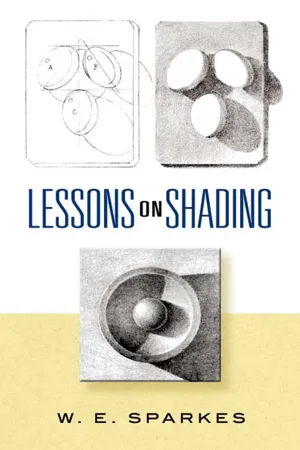
- 112 pages
- English
- ePUB (mobile friendly)
- Available on iOS & Android
eBook - ePub
Lessons on Shading
About this book
It takes the proper infusion of light and shade to accurately represent an object's solidity and character. With this time-honored guide, artists will easily develop a keener, more educated eye for introducing shadow, light, gradation, and reflection to drawings. This insightful study begins with fascinating artistic experiments and exercises, moving on to illuminating advice on how to deepen volume, evoke sunlight, and create mood. Various shapes such as pyramids, cones, spheres, and vases each necessitate different shading techniques, and are all expertly described in a wonderfully instructive tone and eighty-seven skillful illustrations. Thorough guidance on materials and how they should be manipulated to achieve specific effects is also included in this concise and enlightening resource for artists of all levels.
Frequently asked questions
Yes, you can cancel anytime from the Subscription tab in your account settings on the Perlego website. Your subscription will stay active until the end of your current billing period. Learn how to cancel your subscription.
At the moment all of our mobile-responsive ePub books are available to download via the app. Most of our PDFs are also available to download and we're working on making the final remaining ones downloadable now. Learn more here.
Perlego offers two plans: Essential and Complete
- Essential is ideal for learners and professionals who enjoy exploring a wide range of subjects. Access the Essential Library with 800,000+ trusted titles and best-sellers across business, personal growth, and the humanities. Includes unlimited reading time and Standard Read Aloud voice.
- Complete: Perfect for advanced learners and researchers needing full, unrestricted access. Unlock 1.4M+ books across hundreds of subjects, including academic and specialized titles. The Complete Plan also includes advanced features like Premium Read Aloud and Research Assistant.
We are an online textbook subscription service, where you can get access to an entire online library for less than the price of a single book per month. With over 1 million books across 1000+ topics, we’ve got you covered! Learn more here.
Look out for the read-aloud symbol on your next book to see if you can listen to it. The read-aloud tool reads text aloud for you, highlighting the text as it is being read. You can pause it, speed it up and slow it down. Learn more here.
Yes! You can use the Perlego app on both iOS or Android devices to read anytime, anywhere — even offline. Perfect for commutes or when you’re on the go.
Please note we cannot support devices running on iOS 13 and Android 7 or earlier. Learn more about using the app.
Please note we cannot support devices running on iOS 13 and Android 7 or earlier. Learn more about using the app.
Yes, you can access Lessons on Shading by W. E. Sparkes in PDF and/or ePUB format, as well as other popular books in Art & Teaching Art. We have over one million books available in our catalogue for you to explore.
Information
CHAPTER I.
INTRODUCTION.—LIGHTS, SHADES, SHADOWS.
Introduction.
ALTHOUGH objects can be well represented on a flat surface by means of accurately drawn outlines, we find it impossible to express their solidity and the character of their surfaces without the addition of light and shade.
A circular plane and a sphere may each in some positions be rendered in outline by a circle ; a square plane and a cube by a square ; a cone and a sphere by a circle. Under such conditions the difference between the bodies can be expressed only by shading. These are, it is true, extreme cases ; but a moment’s consideration will convince the student that mere outline can never adequately render the delicate variations of the surface of flowers and fruits.
All art is progressive, and is fostered only by careful and exact observation. To the beginner there is little to choose between a tree drawn in outline by Mr. Alfred Parsons, or a figure by Mr. Henry Holiday, and the characterless production of some amateur friend ; and only after much observation does the difference become apparent.
So the educated eye alone is fully alive to all the wonderful variety of light and shade in Nature——in clouds, hills, waves, fruits, trees, and leaves.
At first the reader will be unable to realise the gradations that he is assured are to be found on an object before him. But by carefully noting the well-defined differences of light and shade on geometrical solids, he will in time be able to distinguish the more delicate ones on casts of ornament or on natural objects.
Lights, Shades, Shadows
Place a whitened india-rubber ball upon a dark book-cover, and in a stream of light falling in a direction from left to right of the spectator. (See Fig. 43.)
The surface of the ball appears to be broadly divided into two parts, of which the darker is said to be in shade, the other in light. Moreover, its opaque body deprives part of the book-cover of light: i.e., it casts a shadow. In the following pages this distinction will be maintained. By shadows we shall always mean cast-shadows, and by shades those parts of the surface turned from the direct light.
Now place the ball upon a sheet of white paper, and you will see light, shade, and shadow as before; but the shade appears considerably lighter in parts than before—a change due to light reflected from the paper.
This portion of the shade—for it is always most strongly marked in the shade—is known as the reflected light. It is always present, but is most evident when the reflecting body is light in tone.
Again, that spot on the left side of the egg lying directly opposite the source of light is decidedly brighter than any other part of that side.
This spot is said to be the high light, and the remaining portion is said to be in half tone.
Shadows (A) cast by artificial light.—The character of the shadows cast by artificial light can be best explained by a few simple experiments.
Take two sheets of cardboard and place them at right angles to one another, and in a flood of light from a single source. Then (as in Fig. 1) hold a smaller piece of cardboard with its faces parallel to the perpendicular sheet, so that its shadow may be caught upon the upright plane.
You will notice that the four points a, b, c, d are obtained by drawing lines from the source of light through the four corners of the rectangle; and this you will find true, no matter at what angle you may turn the card.
Fig 1
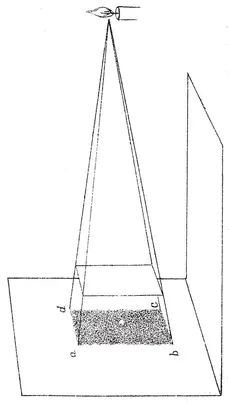
Fig 2
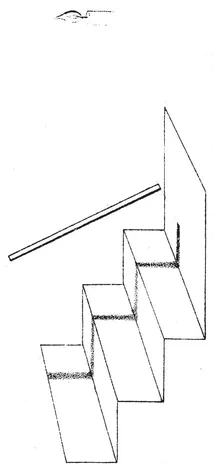
Fig 3
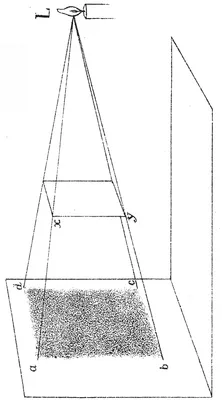
Fig 4
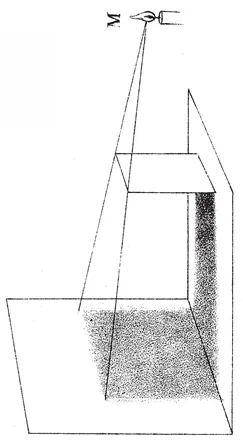
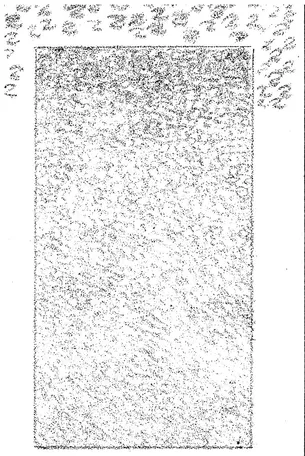
Fig. 5
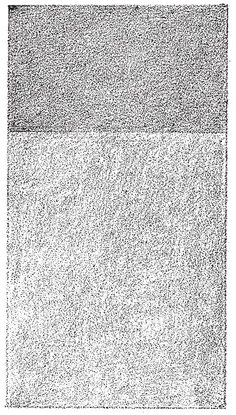
Fig. 6.
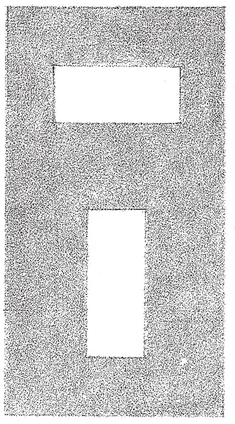
Fig. 7.
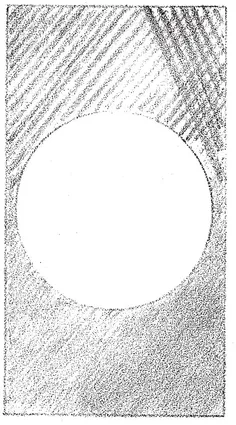
Fig. 8.
We learn then :—(I) The shadow falls immediately behind the object, and along the straight line joining the object with the source of light.
Keeping the light and the sheet of cardboard as before, place the small rectangle nearer the light. The points of the shadow can be found as before ; necessarily the shadow as a whole must be larger (Fig. 3). But you will notice that the tone of the shadow is not so deep as in the last instance, and that its edges are not nearly so distinct.
Hence :—(2) The farther the object from the surface receiving the shadow, the larger and fainter will that shadow appear.
If you now rest the rectangle upon the lower sheet, you will find its shadow cast as in Fig. 4. Here the part of the shadow along the floor, so to speak, gradually decreases in darkness of tone until it reaches the upright, upon which, according to the last experiments, it appears approximately of the same depth throughout.
It will be readily understood why the shadow gets wider along the horizontal plane as it recedes from the object, for the parts receiving the shadow are removed at greater and greater distances from the object. This experiment, therefore, really gives the principles underlying Figs. 1 and 3 in one.
Thus :—(3) The shadows cast on flat surfaces by objects resting on those surfaces appear darkest along the portions nearest the object, whence they gradually decrease in depth.
Lastly, bend the perpendicular sheet into any shape, as in Fig. 2. Place a stick of pencil so that its shadow may be caught, and notice how the sh...
Table of contents
- Title Page
- Copyright Page
- PREFACE.
- Table of Contents
- CHAPTER I. - INTRODUCTION.—LIGHTS, SHADES, SHADOWS.
- CHAPTER II. - ON MATERIALS AND THEIR USE.
- CHAPTER III. - PRELIMINARY EXERCISES.—FLAT TINTS AND GRADATIONS.
- CHAPTER IV. - THE CUBE, HEXAGONAL PRISM, AND CYLINDER.
- CHAPTER V. - ON CONTRAST OF TONES ; AND ON AERIAL PERSPECTIVE.
- CHAPTER VI. - ON PYRAMIDS, THE CONE, AND THE SPHERE.
- CHAPTER VII. - ON VASES, WHITE AND COLOURED.
- CHAPTER VIII. - ON GROUPS; TIME-TESTS; COMMON OBJECTS.
- CHAPTER IX. - ON SHADING FROM THE CAST.
- CHAPTER X. - THE APPLES ; TIME-TEST SHADING FROM THE CAST.
- APPENDICES.